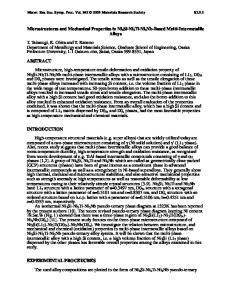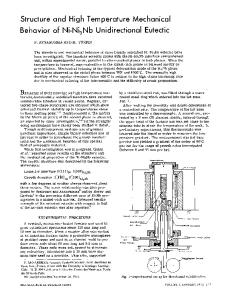The mechanical behavior of nonstoichiometric compounds Ni 3 Si, Ni 3 Ge, and Fe 3 Ga
- PDF / 853,614 Bytes
- 9 Pages / 594 x 774 pts Page_size
- 13 Downloads / 425 Views
I.
INTRODUCTION
A significant amount of research on various L 12compounds has shown that the positive temperature dependence of strength and the defect hardening are considerably affected by the degree of nonstoichiometry.l'2'3 However, most investigations of the effect of nonstoichiometry on the anomalous mechanical behavior have concentrated on Ni3A1, and the only published work on any other isomorphous compounds is that on Ni3Ga by the present authors. 4 Ni3A1 and Ni3Ga have rather wide homogeneity ranges in either side of stoichiometry. Earlier works reported that the positive temperature dependence of strength is greater for A1- or Ga-rich deviations than for Ni-rich deviations. 1'2'3 This feature has been discussed in terms of phase stability of the L12 phase with respect to other phases having geometrically close-packed crystal structure. 4 Of the remaining nickel-base L 1: compounds, the anomalous behavior of Ni3Si was first pointed out by Lowrie 5 and later by Thornton and Davies 6 and that of Ni3Ge by Pak, Saburi, and Nenno. 7 Recently, it has been found by Wee, Noguchi, Oya, and Suzuki that a number of L12 compounds, including Fe3Ga, exhibits the anomalous mechanical behavior. 8 Ni3Si and Ni3Ge have a more strongly positive temperature dependence of strength than Ni3A1 and Ni3Ga, and the homogeneity range of these compounds is limited within the Ni-rich side of stoichiometry, i.e., 22.8 to 24.5 at. pct Si 9 and 23.0 to 25.0 at. pct Ge. ~~On the other hand, the temperature dependence of strength of Pt3A1, Pt3Ga, and Fe3Ga, whose homogeneity ranges are much wider extending to the minority component-rich side of stoichiometry up to 30 at. pct, are more weakly positive than that of Ni3A1 and Ni3Ga. 11'12'13 This paper reports on extension of our previous work on Ni3A1 and Ni3Ga to the nonstoichiometric L12 compound TOMOO SUZUKI and YOSHIHIRO OYA are Professor and Research Staff Member, respectively, Research Laboratory of Precision Machinery and Electronics, Tokyo Institute of Technology, Nagatsuta, Midori-ku, Yokohama 227, Japan. SHOUICHI OCHIAI is Graduate Student, Department of Materials Science and Engineering, Tokyo Institute of Technology, Yokohama 227, Japan. Manuscript submitted October 28, 1982.
METALLURGICAL TRANSACTIONS A
Ni3Si, Ni3Ge, and Fe3Ga, and the results are interpreted in terms of phase.stabilities relative to other ordered structure. Comparison of the different nickel-base L12 compounds that contain 3B-subgroup elements and 4B-subgroup elements has yielded further information on the influence of nonstoichiometry on the anomalous behavior and the defect hardening.
II.
EXPERIMENTAL PROCEDURE
Alloy buttons of 30 g were prepared of 99.97 pct nickel, 99.95 pct iron, and 99.999 pet germanium, silicon, and
gallium by arc-melting. From the small weight losses during preparation and the good reproducibility of the data, compositions were estimated to be within ---0.05 pct. After arc-melting the alloy buttons were sealed in evacuated quartz tubes and homogenized. The phase diagram of Ni-Si
Data Loading...











